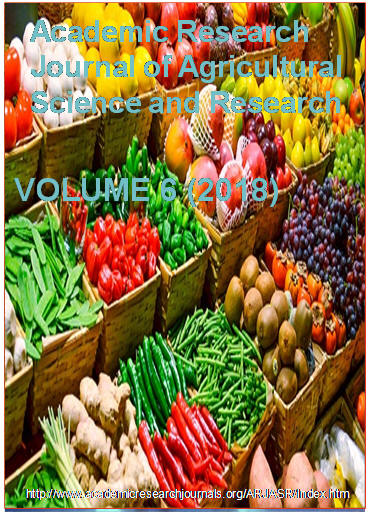| ARJASR |
Academic Research Journal of
Agricultural Science and Research |
||||||||||||||||||||||
|
Academic Research Journal of Agricultural Science and Research Vol. 6(5), pp. 260-265. June, 2018. ISSN: 2360-7874 DOI: 10.14662/ARJASRD2017.080 Full Length Research Prevalence of GIT Parasites and associated risk factors in Cattle of Lume, Bora, Dugda and Adamitulu Jido Kombalcha districts of East Shewa Zone
Shibiru Diriba1 and Dereje Tulu2*
1Jimma Zone Livestock Development and Fishery Office, P. O. Box: 166, Jimma, Ethiopia. 2Tepi Agricultural Research Center, P.O.Box:34. Tepi, Ethiopia. *Corresponding author. E-mail: derejetulu5@gmail.com
Accepted 21 May 2018
A cross-sectional study was carried out from November 2015 to November 2016 to investigate the prevalence and associated risk factors of gastrointestinal parasites of cattle in four districts of east Shewa zone. Fecal samples were examined by using simple flotation techniques. Out of 384 cattle examined 157 (40.9%) were found positive for at least an egg or more of some of parasites belonging to Strongyle, Trichuris, Toxocaravitulorum and/or oocytes of some protozoa. Moreover there was no significant variation (x2=6.61; P>0.05) between districts in finding positive cattle considering the distribution of parasite groups. Based on fecal egg findings, the relative importance of parasites was recorded as Eimeria species, Toxocaravitulorum, Strongyle, Strongyloides species, Trichurisglobulosa and cryptosporidium species in the order of 47.8%, 0.6% 14.0%, 1.3%, 5.1% and 31.2% respectively. Other factors like age category and sex did not show significant variation while body condition was associated with gastrointestinal parasites infections (p< 0.05) were also detected at a considerable rate in cattle despite their history of deworming. No significant variation (P>0.05) was observed to have effect on the infection between cattle based on history of deworming. Considering the current study, gastrointestinal parasites comprising of nematodes and protozoa are common in Lume, Bora, Dugda and Adamitulu Jido Kombalcha districts and pose serious constraints to cattle rearing in the area that necessitate education of farmers. Hence, it is recommended that farmers and extension officers should be educated on the importance of using the right anthelminthic products at the right time in order to improve the economy of farmers keeping cattle in the area.
Keywords: - Gastrointestinal parasites, prevalence, risk factor, cattle, East Shewa
How to cite this article: Diriba S, Tulu D (2018). Prevalence of GIT Parasites and associated risk factors in Cattle of Lume, Bora, Dugda and Adamitulu Jido Kombalcha districts of East Shewa Zone. Acad. Res. J. Agri. Sci. Res. 6(5): 260-265
|
|
|||||||||||||||||||||
